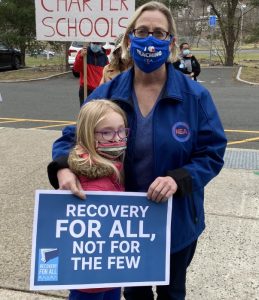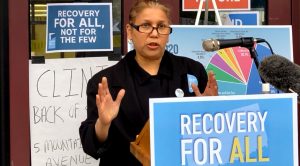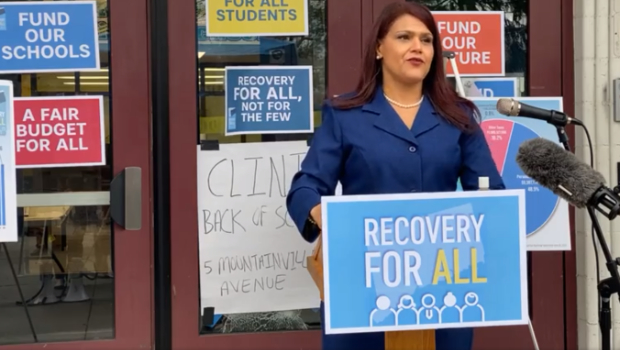Teachers, students, parents, community members, and labor groups assembled yesterday with a clear message for Connecticut’s leaders: Let’s make Connecticut a place where all residents can thrive.
The “speak-out,” held outside Rogers Park Middle School in Danbury, was organized by Recovery for All, a grassroots coalition—including CEA—advocating for a fair budget that invests in schools, families, and communities and gives everyone the opportunity to succeed.
As communities throughout the state face multiple crises caused by the pandemic, they need a state budget that invests in them, along with their children and their schools—not an austerity budget, as proposed by the governor, which will worsen inequality and inequity. The Recovery for All coalition is calling for a revenue system that provides the resources for all of Connecticut’s residents to succeed.
“We need to invest more in our schools, our healthcare system, and affordable housing, but our middle class and working families are stretched so thin, they cannot afford to pay more,” said Senator Julie Kushner, who addressed the crowd along with Reps. Bob Godfrey and Ken Gucker. “That’s why it’s critical that my colleagues and I work together to ensure an economic recovery for all Connecticut residents—one that lifts up our middle class and reduces the growing inequities and widening gap between the super wealthy and those in our state who are struggling to make ends meet.”
The impact of imbalance
Danbury High School student William Sweeney addressed the crowd with great emotion, emphasizing the need for more social workers and school counselors—eliciting cheers and tears.
Sweeney described the heroic work of teachers in his school district, many of whom have 30 students per classroom, as well as school counselors whose caseloads exceed 350 students.
Sweeney named one counselor in particular who proved crucial to his ability to succeed even in the most trying times. That counselor had 350 students in his caseload at the time Sweeney was his student; today, he has 375.
Curtis Darragh—the school counselor Sweeney thanked—was out on the rainy lawn during the speak-out, wiping tears from his eyes not only because he is so well-remembered and regarded by students he has helped but also because he is concerned for the mental health of hundreds of others whose counselors are spread thin.
“I have testified before the legislature about the need to reduce the ratio of students to school counselors to a more manageable 250:1,” Darragh said. “Our students need us more than ever.”
 Also speaking in her capacity as a school counselor was former special education teacher Juanita Harris, who said, “We need you to support a budget that will provide funding for the school counselors, school social workers, and school psychologists needed to address the social-emotional needs of more than 3,000 diverse learners at Danbury High School alone, as well as a budget to address this pandemic’s trauma-related issues our students have been struggling with and are coming into our buildings with.” Harris added that many districts like hers are also dealing with inadequate and outdated technology, high numbers of English learners, growing class sizes and special education caseloads, and intensifying mental health concerns among students—all of which require funding and resources to address.
Also speaking in her capacity as a school counselor was former special education teacher Juanita Harris, who said, “We need you to support a budget that will provide funding for the school counselors, school social workers, and school psychologists needed to address the social-emotional needs of more than 3,000 diverse learners at Danbury High School alone, as well as a budget to address this pandemic’s trauma-related issues our students have been struggling with and are coming into our buildings with.” Harris added that many districts like hers are also dealing with inadequate and outdated technology, high numbers of English learners, growing class sizes and special education caseloads, and intensifying mental health concerns among students—all of which require funding and resources to address.
“It’s time to fully implement the new ECS formula and have a progressive state system that will generate equitable funding for educational improvements like healthy buildings, technology upgrades, mental health services, diverse professional staffing, EL and special education services, and a myriad of needs,” she said.
Danbury High School social studies teacher Julian Shafer, now in his sixth year as an educator, attended the event to show his concern for underfunded schools and his support for his students.
“Pausing ECS funding,” he explained, “makes me feel like any calls for racial equity across the state are empty. With class sizes of 30 students, as hard as we try, we are in a situation that makes it difficult to give students the education they deserve.”
Haves, have-nots
Mary Jo Bohrman, an instructional math coach at Danbury’s Pembroke Elementary School said, “If the pandemic teaches us anything, it’s that we can’t operate as we did before. We can never again be caught off guard where our lack of funding over time deteriorates our infrastructure to such a degree that it prevents us from meeting our students’ most basic needs. This shouldn’t be afforded to just certain districts in our state.”
More than a dozen speakers shared their personal stories about underfunded public schools and other struggles facing students and families, including a disproportionate number of people of color, who are suffering from food insecurity, threats of eviction, and lack of healthcare.
“For more than a decade, the City of Danbury and the State of Connecticut have left our students with the paltry remains at the bottom of the school funding barrel,” said Erin Daly, a third-grade teacher and president of NEA Danbury. “Our children have a right to an equitable education. The injustice in school funding puts our students at a disadvantage compared to students in every other district in Connecticut.”
Luanelly Iglesias (pictured at the top of this page), a bilingual educator in Danbury and a single mother, has experienced the hardships caused by the state’s inequitable tax structure both in her personal life and in her classroom.

Danbury math teacher Lammia Agoora.
“I have seen many unmotivated and depressed students after their parents lost their jobs, couldn’t afford to pay their bills, and had to move in with friends or relatives. Our schools require critical funding to meet the growing needs of our students, including more support for English learners and students who receive special services, counselors, health services, and other important programs that provide our students with the best opportunities to succeed,” said Iglesias.
“In a state with great financial resources,” said CEA Executive Director Donald Williams, “we have the ability to meet the challenge of this moment and pave the way for a better and stronger Connecticut. In fact, it’s our obligation to do so.”
“We are a Title I district, and we have teachers who do so much with so little,” said Danbury math teacher Lammia Agoora. Describing what she called a perfect storm brewing, she cautioned against the governor’s budget, which eliminates millions in funding that districts like Danbury need—continuing a long pattern of state underfunding at the same time schools have been drastically overcrowded. Properly funding schools, she said, would benefit students by providing smaller class sizes, tutors, technology for the 21st century, before- and after-school programs to close achievement gaps and offer academic, social, and emotional support, and additional resources to bridge the language gap for English learners.
Join Danbury educators and educators across the state who are rising up to demand full funding for our schools by registering for a statewide CEA Recovery for All Meeting Monday, March 29, at 4:30 pm. Learn more about this educator-led campaign to fund our future—and what you can do to help.







